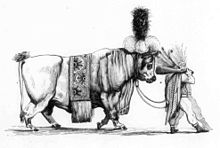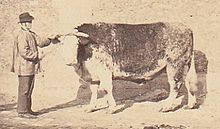Parade of the Fat Ox at the Paris Carnival
This event has served as a source of inspiration for a variety of artistic and cultural expressions, including theatrical plays, operettas, references in La traviata, political, satirical, comedic, and carnival songs, as well as poetry.
In a 1739 issue of Mercure de France describing the Parade of the Fat Ox, it states: "This very old custom appears to be a remnant of certain pagan festivals, particularly sacrifices offered to false gods.
In 1852, Edmond Auguste Texier claimed that the festival of the god Apis was passed down to the Greeks and Romans in the form of the cult of Mithras—though he overlooked its Eastern origins—and subsequently spread to Gaul through conquest.
[11] Jacques Antoine Dulaure [fr] posited that the festival was initially celebrated at the spring equinox, when the sun entered the sign of Taurus, potentially deriving from astral worship.
[2] An additional explanation is provided in a document printed in 1896, which is preserved in the Carnival Archives of the Historical Library of the City of Paris:[N 2] For a long time, civil and religious laws prohibited the consumption of fatty foods during Lent, except for the sick.
[11] Folklore group leader Suzanne Manot synthesized a series of theories, proposing that the Parade of the Fat Ox symbolizes the Christianization of ancient festivals—including Egyptian, Greek, Roman, and Gaulish traditions—observed at the spring equinox in tribute to oxen believed to possess divine abilities.
[21] Seven years later, Louvel attended the Fat Ox parade before fatally stabbing the Duke of Berry,[22] and street festivities were subsequently banned by Police Prefect Jules Anglès.
[43][44] However, the change in government following the fall of the Floquet administration in 1889, as documented by M. Champimont, prevented the Fat Ox's revival that year, thus necessitating the restart of negotiations that had been progressing with the former Minister of the Interior.
[59] He was joined by Caumeau,[60] and together they issued a report on 28 November 1895, explaining that the Butchers’ Union planned to organize the Fat Ox Parade through funds raised via a lottery worth 500,000 francs.
[77][N 5] In the early 20th century, the Bœuf Gras parade emerged as a prominent feature of the Food Festival held in the La Villette district, including a procession on 25 February.
[84] A subsequent parade, organized with a budget of 5,000 francs—a sum derived from the remaining funds of the 1900 Bœuf Gras festival and substantial contributions from merchants and residents of the 19th and 10th arrondissements, following the rejection of a municipal subsidy request[85][86][87]—occurred ten days later in the La Villette district.
The newspaper wrote: "Never has a plump ox exhibited for the public’s amusement aroused such delighted curiosity, and laughter erupted in bursts as the floats passed by, where picturesque allegories proclaimed the glory of wine and the Rabelaisian triumph of feasting."
On 20 June, the City Council approved an exceptional grant of 4,400 francs to help cover the deficit and avoid legal action against the merchants involved, whom they deemed undeserving of such consequences.
Bank, also known as that of the La Villette slaughterhouses;[91][92] and on 7 March, in the procession for Mid-Lent Thursday, a large papier-mâché Bœuf Gras, humorously described as "not having cost much to fatten," was featured.
It was led by a group of butcher boys attired in Turkish garb and mounted on horseback, marching to the melody of wind instruments performing the composition Malbrough s'en va-t-en guerre.
[6] However, on Sunday, 10 February 1812, in the Place du Théâtre-des-Italiens, the Parisian Bœuf Gras, or bull, dropped the child it was carrying, ran off, and knocked over several people, and was only caught with great difficulty.
[127] In 1821, the Journal des débats, describing the arrival of the Bœuf Gras parade at the Tuileries Palace, noted that "the child who is usually mounted on the ox was carried by a man.
[28] The following year, upon its return to Paris, the Norman Bœuf Gras Liberté, adorned with a golden embroidered cover trimmed with gold and flowers, is preceded by a detachment of cavalry from the Republican Guard and a company of drummers dressed as janissaries.
A delegation of Norman cattle breeders follows, along with a float carrying five women representing Ceres and the four seasons, knights "in the medieval style," and cavalry from the Republican Guard bringing up the rear.
They were followed by two heiduques with long staffs topped with large golden apples, a drum major, drummers, and musicians dressed in Louis XV-style costumes, light blue with silver trim.
[20] At the close of December 1895, the Paris City Council articulated its desire for the procession, which was to be reinstated in 1896 "due to its extraordinary proportions," to commence at the Arc de Triomphe and traverse the Avenue des Champs-Élysées.
[142]However, two days later, Le Moniteur parisien refuted the narrative of the street slaughter, asserting that the animal, unable to continue the parade, was subsequently transferred to the Poissy stockyard, where it spent the night.
[26] Two years later, Gustave Flaubert wrote to Louise Colet: If you want to measure what public esteem is worth, and what a beautiful thing it is to be ‘pointed at,’ as the Latin poet says, you have to go out in the streets of Paris on Mardi Gras.
[147]At the conclusion of February 1860, Louis Jourdan, a prominent publisher who harbors a strong animosity toward the Paris Carnival, expresses his discontent regarding the Parisians' profound devotion to the Bœuf Gras tradition.
[134] In 1857, Pierre Véron, in a poem that expresses disdain for the Paris Carnival, titled Un Mardi-Gras à Saint-Cloud, lamented: For Victor Hugo, in Les Misérables (1862), the Bœuf Gras celebration is part of the "magnificent and joyful processions.
"[151] According to the perspective of illustrator and caricaturist Bertall, the conclusion of the Bœuf Gras in 1876 signaled the termination of the Paris Carnival, with only private nocturnal festivities persisting as authentically traditional.
He asserted that this was a satisfactory solution, and that the rulers, who had refused for so many years to bring back the traditional Bœuf Gras, could at least offer a small compensatory pleasure to the Parisian population.
[155] During its last revival in 1998, ethnologist Anne-Marie Brisebarre [fr] criticized a project she viewed as political and lacking cultural value, as it kept little of the original tradition and its festive, religious, and professional meaning.
[206]An integral component of popular culture, numerous private organizations have adopted the theme of the Bœuf Gras.On 15 March 1849, to commemorate Mi-Carême, the 2nd Children's Ball was orchestrated at the Jardin d'Hiver.
[207] Three years later, on 24 February 1852, at an opulent masked ball hosted by Charles Ponchard and his wife, attended by numerous artists including Jacques Offenbach, a miniature Bœuf Gras paraded: After three encores of the Cris de Paris (a comic waltz composed for the occasion by Victor Parizot) and the comical performance of Polka des Bêtes Fauves, a very pleasant lyrical hors d'œuvre, created by the whimsical conductor of the Montansier, Mr. Hervé, the march of the Bœuf-Gras appeared with its banners and halberds, trumpets, and led by Mr. Cerclier from the Opéra-Comique.


































